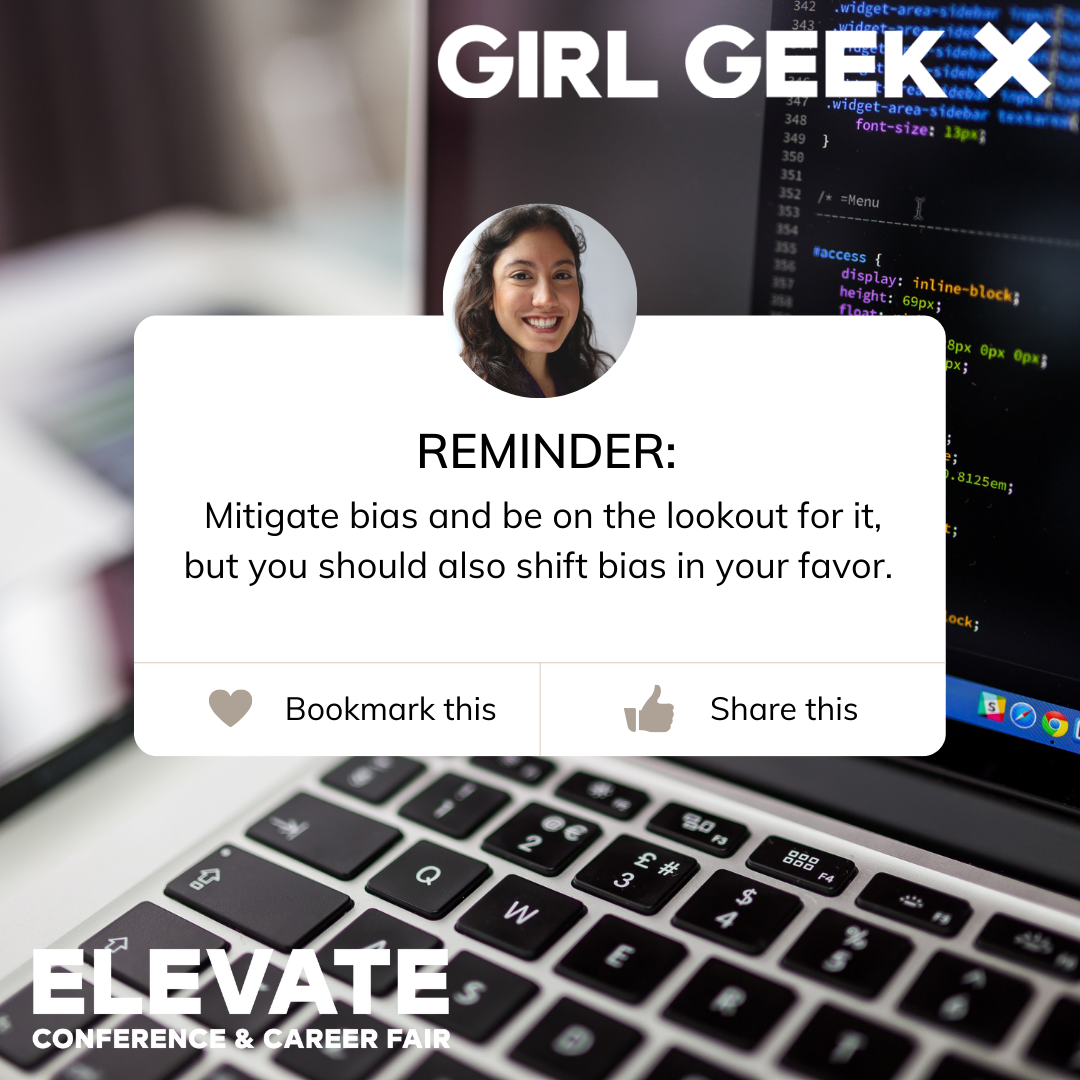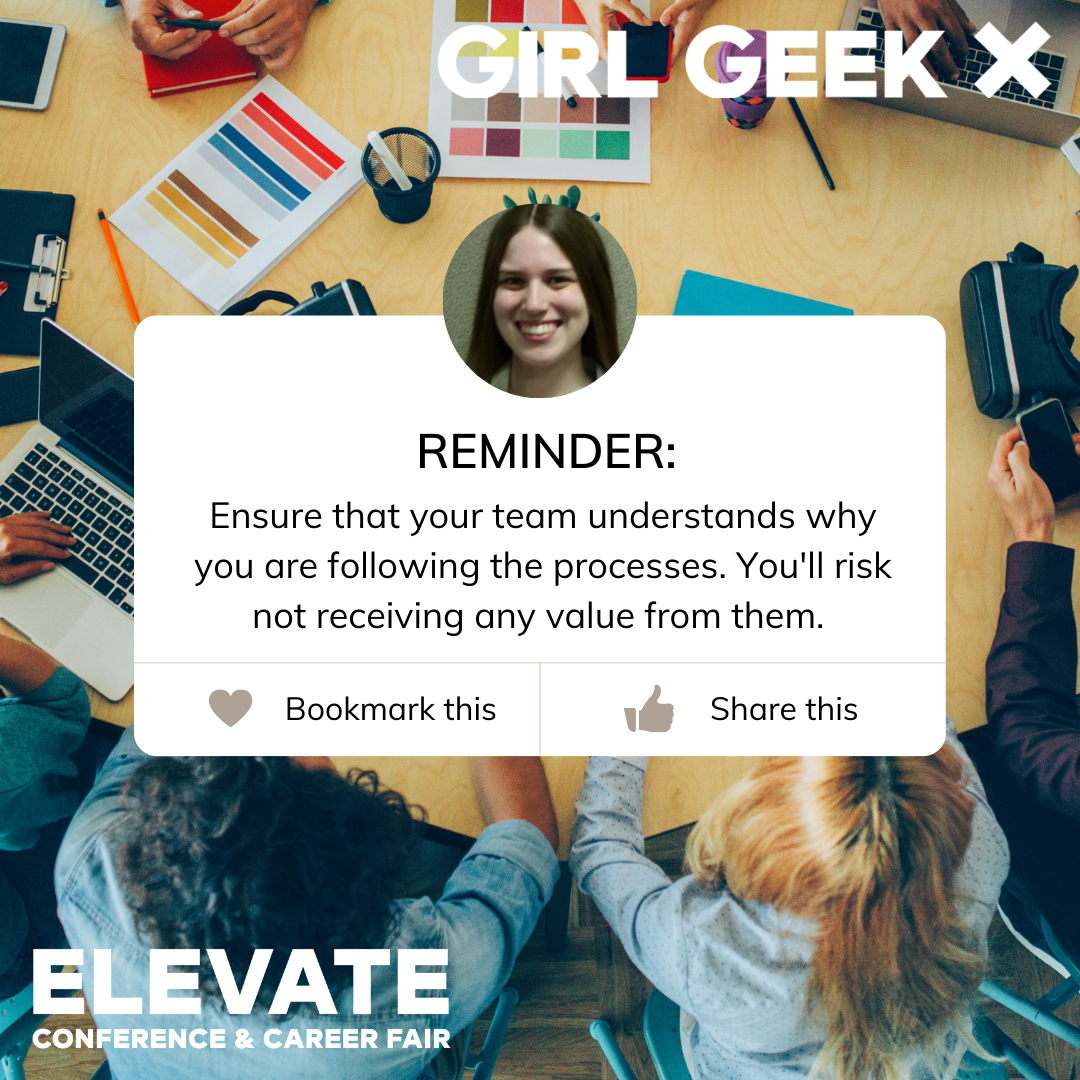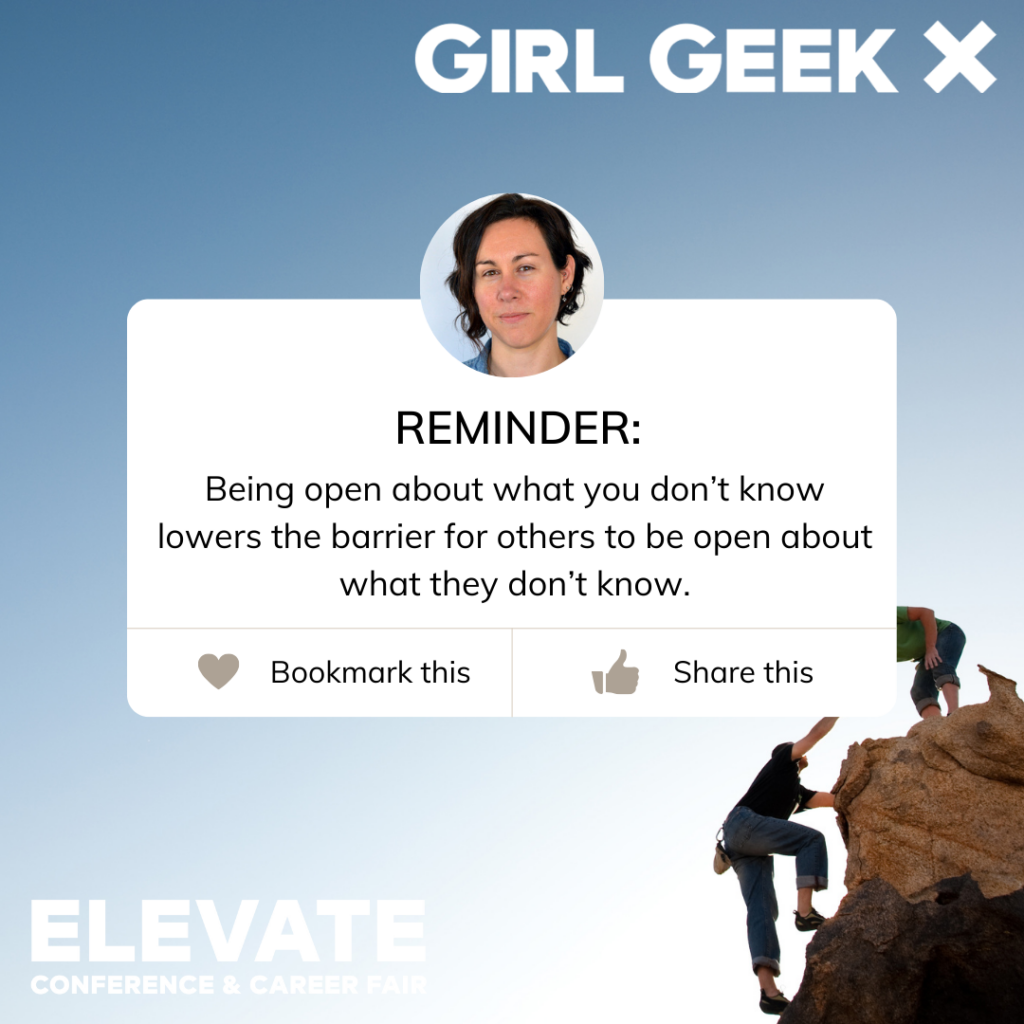In this ELEVATE session, Iren Azra Zou (Senior Software Engineer at TandemAI) teaches you how to align with your managers and their managers about what they value, as not all leadership and all initiatives are rewarded equally unfortunately. She discusses improving your visibility and personal brand, and what do you do if none of this works out for you.
Like what you see here? Our mission-aligned Girl Geek X partners are hiring!
- Check out open jobs at our trusted partner companies!
- Watch more ELEVATE 2024 videos from the event, or just the “Best Of 2024” Videos!
- Does your company want to sponsor a Girl Geek Dinner or Virtual Conference? Talk to us!

Transcript of ELEVATE Session:
Iren Azra Zou:
Hi everyone. Super excited to be here. Thank you so much for coming. So today we’ll be talking about how to get promoted, what we think that leads to promotion, and then what they don’t tell us about promotions. But before I start, let me make a quick intro about myself. I was born and raised in Turkey. I came to California to study at Pomona College. I studied computer science and molecular biology and a little bit of French. Then I started working at Schrodinger, which is a computational drug discovery company that I moved on to TandemAI, which is a drug discovery company.
I really love mentoring, teaching, speaking, all of that. I have multiple things going on in multiple sites, and I also love connecting with people, so I’m very active on LinkedIn. And lastly, I live in New Jersey with my husband and my three wonderful cats.
Let’s get started with the first myth. The first myth is titles don’t matter. Unsurprisingly, titles obviously do matter quite a bit. First of all, they’re correlated with your salary, which is important because we want equitable pay. It’s correlated with how much status you have in your organization and not even just your organization. It’s correlated with how much status you have in the industry in general, which is very important because it determines what kind of opportunities you get.
Titles actually attract recruiters and hiring managers. I got reached out by hiring managers because I got promoted so fast. This is literally what they told me, so that’s a factor as well. Even interview difficulty. Sometimes if you interview as a senior, for example, they’re going to ask you fewer technical questions because they’re going to assume that.
Lastly, I want to emphasize the compound effect, right? The earlier you get promoted, the earlier your salary will start increasing, and raises are obviously based on your salary before the raise. Similarly, the earlier you get status, the earlier you’ll get opportunities. So it’s not really a linear progress, but more exponential.
The second myth, we all kind of want to believe this, but that’s actually not how the world works. If you work hard, people will recognize it, AKA if you work out, you’re get a promotion, but promotions are given for high promise. Are you going to be able to perform well in this level above your current level? Are you already performing the tasks that you will be performing when you’re promoted? That’s the kind of metric that people tend to use. People say that they’re using, but it turns out we’re terrible at determining whether someone has high potential or not, whether someone has high promise or not.
This is a research paper that showed us women are 14% less likely to get promoted because they get lower potential ratings even though they have higher performance. Higher performance won’t necessarily lead to a promotion. How do you show that you have potential promise? One thing you can do is you can focus on leadership and focus on the initiatives that you start yourself.
One good way to do this is delegate. What are you doing right now that you got so good at that you can maybe pass that down to someone else and pick up something that’s new, that’s a little above your current level. Again, performing up a level, what are the tasks that people are performing at the level above you are there?
Are there performing the same tasks maybe to a different quality? Your manager would be a good resource to ask about this. Just straight up. Ask them what is the kind of tasks I would be performing if I was promoted? Another thing to ask yourself that might be helpful is, what does your manager not like doing? Can you take that on? Because if you can do his job or her job or their job, it means that you can perform at the higher level. That’s a good question to ask as well.
Now we come on to myth three. I just told you leadership and initiative, but even if you show leadership and initiative, even if you’re the best leader in the world, you might not be fine because you need to lead visible projects because even if you do the best leadership, if nobody saw it, it didn’t happen.
It’s kind of like Instagram, it didn’t happen, right? Somebody needs to see it, so you’ve got to go after the right projects. But how do you go after the right projects? And the answer is to align. You need to align with your teammates, you need to align with your managers. You need to align with the rest of the company about what’s important and what’s bringing success to the team or the company as a whole.
One way to do that is ask yourself, what is an important piece of my team? If you’re a software engineer, for example, what’s an important service that no one really likes? Because maybe it’s hard. Maybe it’s complicated, but it’s important. Can I take that on to show that I’m doing this great work and everybody’s eyes is going to be on there because it’s so important and everybody hates it.
Another question that you can ask is, is there something new and shiny that’s possibly also on fire that nobody wants to own? This is a good way to proceed as well. Other good questions to ask yourself is, does this project have a lot of natural followers? Are there a lot of people depending on this project in the company? Maybe not just only your team, but is the people in the company overall kind of watching this project somehow? Or is this project related to something else that they’re watching very closely? Usually cross team projects. Projects that have people from multiple teams working on them tend to fit all of these.
Are there any cross team projects available in your team? You can also check out your companies goals, like what is generating revenue? What are some other key performance indicators? Are the projects that you have the ability to take on touching any of these directly so you can show them when you’re done with this project? And lastly, aligning with your manager, asking your manager what they think needs improving, what they complain about all the time is a good way to find what projects will bring you the right kind of visibility, if that makes sense. Speaking of aligning
Okay, you asked your manager, oh, does this project have high visibility? Does this project have high impact? And they were like, yeah, and then they not. It means that you’re aligned. It means that you’re done. Unfortunately, promotion criteria and conversations about impact tend to be very, very, very vague. When you have a conversation about them, it’s really easy to just say Yes. Oh, does this project have impact? Sure, every project has impact. That’s kind of not the question you’re trying to ask, what you’re trying to identify with your managers, is this the best project that I can take on with my abilities and I’m a driven person? Is this the best thing I can take on right now? But that’s a very hard conversation to have because it’s a continuous conversation you’ll probably need to keep realigning. I think the best way to do this is documenting constantly and sharing that documentation with your manager.
For example, during your one-on-ones, and if you don’t have a one-on-one with your manager, you should start having it immediately. It started on Monday. So the key takeaways that you get from your one-on-one, let’s say you ask, oh, is this project the right kind of project that will give me this kind of visibility? Write that down, share your screen and write it down as they’re staring at your notes. Not only will this make the conversation easier because you’re both going to be on top of it, if you need to get back to the sum of day, you’re going to have very detailed notes about it, but you’re also writing it down so immediately they’re more accountable for everything that comes out of their mouth, which kind of makes them, gives them an incentive to focus on actually what you’re trying to achieve Here. You can do the same thing with next title level goals.
What are the expectations? What am I missing? What am I doing? Great, what am I missing? Write all of those down in detail. So one, you’re not going to miss anything. And again, they’re going to feel more accountable because now it’s in written form. And maybe the best thing about this is that you can take this document and take it to your manager’s manager and their manager and maybe other managers that you know and be like, I heard this from my manager. Do you think this makes sense? Is this really how we make decisions in this company? Do you guys align with what I think I know, okay, this myth breaks my heart. But just because we’re working with nice people, nice people who are aware, nice people who read about bias and everything, doesn’t mean that we can start worrying about bias. Because the hard truth is if you have a brand, you have bias.
I have bias. You have bias. Your manager has bias, their reports have bias. Everybody has bias. So you kind of need to watch out for bias. Sometimes this shows up in the form of racism and sexism. We show an example at the beginning of this talk. Men are seen to have more potential usually, or it can show itself in more relatively innocent ways like negativity bias and recency bias. We want to be on the lookout for bias. The best way to do that is to be knowledgeable of all the different kinds of bias. And when you see a bias, say you’re in a meeting and people are paying more attention to what happened recently compared to the whole picture of the whole year, let’s say you can be, thanks for sharing that, but it looks a little bit like recency bias. And the moment you name it again, you create kind of this accountability because now you kind of underlined how serious the mistake can be.
And lastly, you want to be really aware of all the company policies, especially the performance evaluation one, so that you can see whether they’re doing anything to mitigate bias. If they’re not, most likely there will be bias in the process. Speaking of mitigating bias, here are a few things that you should definitely do to mitigate bias during your performance evaluation.
The first thing is recency bias. Since you have been talking to your manager in one-on-ones taking detailed notes, you have a very detailed account of all their accomplishments and you can put those in a form to send to your manager so that your manager is not evaluating you on the most recent things that happened, but they’re evaluating you for the whole year. This is very helpful if let’s say you made a small mistake right before the performance evaluation cycle, so you prevent them from diving into that more than they should.
The other thing that you should definitely do is eliminate the time pressure off of your manager as much as you can, because when people are under time pressure, they tend to make more biased decisions, which is not surprising at all, right? Start two months-ish earlier than the deadline starts helping your manager to craft your performance evaluation with you. Not only should you mitigate bias and be on the lookout for it, but you should also shift bias in your favor.
If something happens and somebody is going to make a bias decision about you, the bias is more positive leaning than negative leaning. But how can you do that? It all comes down to visibility and personal brand. You want to position someone as someone who’s a mentor, someone who’s helpful, someone who’s a thought leader in the company and in your team.
There are a few ways you can do that. One of the best ways is being active in chat rooms. When people ask questions, try to answer them. If somebody asks you, if you get a certain question a lot like create a post about it. Sharing similarly, doing blogs or talks in your company doing summary emails of important meetings with your additions. Individual networking is also important.
You can do coffee chats with people, you can have networking with people who are not in your team. For example, you should definitely have a friend from HR that comes in handy. Giving credit is a great way to bring visibility both to you and other people.
And last tip, try to be on projects with more senior people because when they inevitably write your review, their weight a little bit higher than someone with lower title. This is another reason why titles matter, right?
Going back to myth number one. Another thing that’s really easy to assume is, oh, promotions are very important. Literally my, my career is dependent on this. Obviously my manager, who’s a great person, should be doing a good job. They should care a lot about it.
Unfortunately, that doesn’t really seem to be the case because most managers actually don’t like doing this. This is not their day-to-day job. This is not what they chose to do. They don’t know how to be thorough with the process. They don’t know enough about bias to see it, to name it, to mitigate it. They don’t have qualified mentors to teach them how to do it properly. And most importantly, they’re not praised for doing this, right? There is no reward for getting this process right, even if it’s really important. You need to assume complete incompetency not only from your manager, but everybody involved in the process.
You need to know the steps in the performance evaluation process, checks and balances if they exist. Weaknesses, what kind of bias can exist? Timelines, can you get promoted at the beginning of the year only or can you get promoted at the end in the middle? How does it work? Also, you need to manage up. I actually was the person who told a few managers that media promotions are possible. They didn’t know that, but I did because I had that HR friend.
You also need to look into promotion criteria. Discuss this with your manager. Make them understand and fit into the general understanding in the company, so when they lead you, they lead you in the right direction and help them with paperwork. Speaking of helping them with paperwork, you have been talking about these kinds of things all year with your manager.
If you know what they need to write to enter the performance promotion process, you can kind of start writing those prompts for them without kind of telling them. You can give them a lot of data that they can copy paste easily. Just getting include stuff like detailed examples of the awesome things that you did. Numbers like how many teams have you supported, teams you affected, people you mentored, number of interviews, production issues, design documents, any number that’s significant in this performance evaluation process presented in a form that is going to be helpful to your manager that can literally be copied and pasted.
This principle of not comparing yourself to others works well if the criteria is well-defined, but if the criteria are not well-defined, how are you supposed to know whether the system works in the way they promised you it will work? You kind of need to compare yourself to other people. You need to recognize who gets promoted. You need to recognize what people are working on, where the things that they said would be rewarded are the things that are actually being rewarded or are the projects that they said had impact were actually the projects that had impact. You need to look for discrepancies. This is also a good way to see what brings visibility to people, so you can kind of learn from it and copy it a little bit and realign be align with your manager and their managers about, okay, this is what we thought about, but this is what happened.
Maybe we need to talk about this again. Lastly, I hear this a lot, especially from women saying things like, oh, it’s not important. If use is not going to make a difference, just get over it. But there’s an opportunity cost. We just talked about how if you get status early, you’re going to get more status, more opportunity.
There’s an opportunity cost to waiting. Also, things not being fair, doesn’t feel nice. Also,, this can decrease your job satisfaction, which can actually decrease your performance and can have an impact on your career overall. You got to seek accountability. If something doesn’t make sense, if something doesn’t look fair, if something isn’t transparent, please talk about it. And the same research paper that said that women are ready to have less promise also so that women are less likely to leave when they’re faced with unfairness.
Maybe if you’re faced with big unfairness, maybe try leaving. And if you’re going to try leaving, maybe go to a place with more women than minorities because that tends to decrease. Performance evaluation binds.
Today is International Women’s Day and today’s the day to celebrate a hundred percent, but today is also the day to think about the kind of future we would like to build. I invite all of you to look at your company’s promotion process and see what you can do to improve it. Thank you so much. I will like three-ish minutes. I would love to take questions, comments, and if we run out of time, please reach out to me. I love to talk to people. Thank you so much. Let me look at the chat.
Is there a time link You should wait before you look into wanting to get a promotion. So this is, I think very, it’s really important to be aware of what’s happening because let me give you an example. Maybe a senior developer in the industry is someone who has eight years of experience, let’s say. But maybe in your company, people are getting promoted left and right in a year, so then you shouldn’t wait for eight years. Looking around and being aware of how long it took other people is a good indicator. Also, I would just ask my manager about it. How long do you think this will take? If that makes sense.
Sense. I wish we had more time, but the next question is amazing. Any tips? When I’m working for a disengaged manager, I think the whole accountability piece will force them to be more engaged. Also, if you are talking to their managers, maybe that fact will also keep them a little bit more engaged. I think if none of that is working, I would head on tell them, I feel like you’re a little disengaged. Is there anything I can do to make this more valuable for our common goals? And if none of that works, I would try to change my manager or change my job.
Like what you see here? Our mission-aligned Girl Geek X partners are hiring!
- Check out open jobs at our trusted partner companies!
- Watch more ELEVATE 2024 videos from the event, or just the “Best Of 2024” Videos!
- Does your company want to sponsor a Girl Geek Dinner or Virtual Conference? Talk to us!











